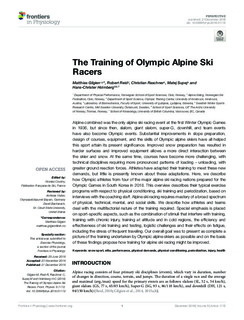The Training of Olympic Alpine Ski Racers
| dc.contributor.author | Gilgien, Matthias | |
| dc.contributor.author | Reid, Robert Cortas | |
| dc.contributor.author | Raschner, Christian | |
| dc.contributor.author | Supej, Matej | |
| dc.contributor.author | Holmberg, Hans-Christer | |
| dc.date.accessioned | 2019-04-29T10:32:58Z | |
| dc.date.available | 2019-04-29T10:32:58Z | |
| dc.date.created | 2019-01-30T23:06:26Z | |
| dc.date.issued | 2018 | |
| dc.identifier.citation | Frontiers in Physiology. 2018, 9, 1772. | nb_NO |
| dc.identifier.issn | 1664-042X | |
| dc.identifier.uri | http://hdl.handle.net/11250/2595905 | |
| dc.description | This is an open-access article distributed under the terms of the Creative Commons Attribution License (CC BY). The use, distribution or reproduction in other forums is permitted, provided the original author(s) and the copyright owner(s) are credited and that the original publication in this journal is cited, in accordance with accepted academic practice. No use, distribution or reproduction is permitted which does not comply with these terms. | nb_NO |
| dc.description.abstract | Alpine combined was the only alpine ski racing event at the first Winter Olympic Games in 1936, but since then, slalom, giant slalom, super-G, downhill, and team events have also become Olympic events. Substantial improvements in slope preparation, design of courses, equipment, and the skills of Olympic alpine skiers have all helped this sport attain its present significance. Improved snow preparation has resulted in harder surfaces and improved equipment allows a more direct interaction between the skier and snow. At the same time, courses have become more challenging, with technical disciplines requiring more pronounced patterns of loading – unloading, with greater ground reaction forces. Athletes have adapted their training to meet these new demands, but little is presently known about these adaptations. Here, we describe how Olympic athletes from four of the major alpine ski racing nations prepared for the Olympic Games in South Korea in 2018. This overview describes their typical exercise programs with respect to physical conditioning, ski training and periodization, based on interviews with the coaching staff. Alpine ski racing requires mastery of a broad spectrum of physical, technical, mental, and social skills. We describe how athletes and teams deal with the multifactorial nature of the training required. Special emphasis is placed on sport-specific aspects, such as the combination of stimuli that interfere with training, training with chronic injury, training at altitude and in cold regions, the efficiency and effectiveness of ski training and testing, logistic challenges and their effects on fatigue, including the stress of frequent traveling. Our overall goal was to present as complete a picture of the training undertaken by Olympic alpine skiers as possible and on the basis of these findings propose how training for alpine ski racing might be improved. | nb_NO |
| dc.language.iso | eng | nb_NO |
| dc.subject | snow sport | nb_NO |
| dc.subject | elite | nb_NO |
| dc.subject | performance | nb_NO |
| dc.subject | physical demands | nb_NO |
| dc.subject | physical conditioning | nb_NO |
| dc.subject | periodization | nb_NO |
| dc.subject | injury | nb_NO |
| dc.subject | health | nb_NO |
| dc.title | The Training of Olympic Alpine Ski Racers | nb_NO |
| dc.type | Journal article | nb_NO |
| dc.type | Peer reviewed | nb_NO |
| dc.description.version | publishedVersion | nb_NO |
| dc.rights.holder | © 2018 Gilgien, Reid, Raschner, Supej and Holmberg | nb_NO |
| dc.source.journal | Frontiers in Physiology | nb_NO |
| dc.identifier.doi | 10.3389/fphys.2018.01772 | |
| dc.identifier.cristin | 1669561 | |
| dc.description.localcode | Seksjon for fysisk prestasjonsevne / Department of Physical Performance | nb_NO |
| cristin.unitcode | 150,31,0,0 | |
| cristin.unitname | Seksjon for fysisk prestasjonsevne | |
| cristin.ispublished | true | |
| cristin.fulltext | original | |
| cristin.qualitycode | 1 |
Tilhørende fil(er)
Denne innførselen finnes i følgende samling(er)
-
Artikler / Articles [2096]
-
Publikasjoner fra Cristin [1084]
